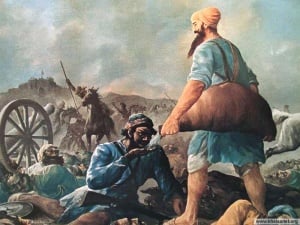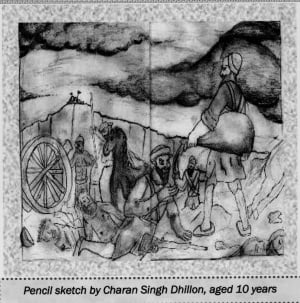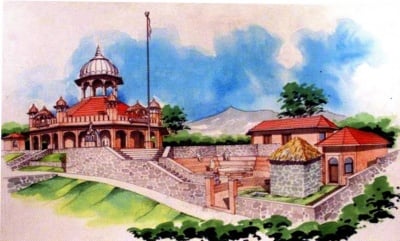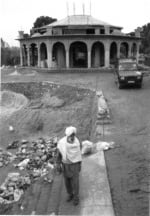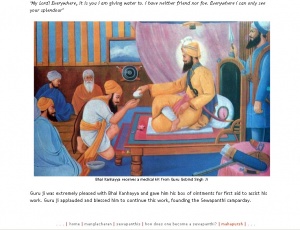Bhai Kanhaiya
Bhai Kanhaiya or Bhai Ghanaiya (1648 - 1718) (also spelt Ghaniya, Kanhiya), was a Sikh of Guru Tegh Bahadur and was the founder of the Sevapanthi or Addanshahi samparday (brotherly orders) of the Sikhs.
He was born in a Dhamman Khatri family of Sodhara near Wazirabad in Sialkot district (now in Pakistan) and his father was a wealthy trader. The village was named Sodhara as it was said to have 100 doors and pathways into it.
From a very young age Bhai Sahib use to keep coins in his pocket so he could give them to anyone he saw who was in an unfortunate position. The locals were astonished at the compassion and thoughtful nature of someone so young. As he grew a little older he began to help the poor in other ways. He would wait on the paths of the village and when seeing a poor person carrying a heavy load he would offer to carry the weight for them for a few miles. He would do this every day, carry the heavy weight poor people were forced to carry on their heads for many miles back and forth from the village. When Bhai Kanhaiya's mother found out she was worried that people would think poorly of a rich trader's son doing such menial labor. But Bhai Kanhaiya was adamant, insisting he was unable to see the suffering of others and would do anything in his power to alleviate some of their hardships even for a few hours. This shows that Bhai Sahib had compassion and a desire to help others from a very young age.
After Bhai Sahib's father passed away, Bhai Kanhaiya Ji took over the family business. While trading one day he came across a devotee of Guru Tegh Bahadur Ji called Bhai Nanua Ji. Bhai Nanua was a loving Sikh who woke up early at Amritvela to recite Gurbani. One morning Bhai Kanhaiya sat with Nanua Jee and was captivated with the Shabads that he heard:
One Universal Creator God. By The Grace Of The True Guru: Raag Gauree, Ninth Mehla: Holy Saadhus: forsake the pride of your mind. Sexual desire, anger and the company of evil people - run away from them, day and night. ||1||Pause||One who knows that pain and pleasure are both the same, and honor and dishonor as well, who remains detached from joy and sorrow, realizes the true essence in the world. ||1||Renounce both praise and blame; seek instead the state of Nirvaanaa.O servant Nanak, this is such a difficult game; only a few Gurmukhs understand it! ||2||1||
Sorat'h, Ninth Mehla:O dear friend, know this in your mind. The world is entangled in its own pleasures; no one is for anyone else. ||1||Pause||In good times, many come and sit together, surrounding you on all four sides.But when hard times come, they all leave, and no one comes near you. ||1||Your wife, whom you love so much, and who has remained ever attached to you, runs away crying, ""Ghost! Ghost!"", as soon as the swan-soul leaves this body. ||2||This is the way they act - those whom we love so much. At the very last moment, O Nanak, no one is any use at all, except the Dear Lord. ||3||12||139||
One Universal Creator God. By The Grace Of The True Guru: Salok, Ninth Mehla: If you do not sing the Praises of the Lord, your life is rendered useless. Says Nanak, meditate, vibrate upon the Lord; immerse your mind in Him, like the fish in the water. ||1||
Upon hearing the above Bani written by Guru Tegh Bahadur Jee Bhai Kanhaiya's soul was awakened. He had not thought about the reality of death and the importance of meditation. Although he had carried out many good deeds he realized he had missed the essence of Naam and Gurbani too. Then upon hearing the following:
The Naam remains; the Holy Saints remain; the Guru, the Lord of the Universe, remains. Says Nanak, how rare are those who chant the Guru's Mantra in this world. ||56||
Bhai Kanhaiya asked Bhai Nanua to let him know the Mantra of the world. Bhai Nanua directed Bhai Kanhaiya Ji to visit Guru Tegh Bahadar Ji to discover more so Bhai Kanhaiya immediately left.
His quest ended when he met Guru Tegh Bahadur and accepted initiation as a Sikh at his hands. Here Bhai Sahib stayed and continued to serve the Sangat. Bhai Kanhaiya was the designated water carrier for Guru Ji and afterwards in Langar. He also looked after Guru Sahib's horses as a stable hand. While serving the horses one day, Guru Tegh Bahadur Ji visited Bhai Kanhaiya and blessed him, advising him that his future should be filled with serving humanity at large.
Kanhaiya established a Dharmshala at Kavha village in the present Attock district of Pakistan which he turned into a preaching centre.
His special mission was selfless service of humanity with no distinction of nationality, caste or creed. In 1704/5, he was on a visit to Anandpur when the city was attacked by a combination of Rajput hill troops and their Mughal allies.
Non-discriminatory Service
During the frequent sallies and skirmishes between the Sikhs and the enemy around Anandpur, Bhai Kanhaiya was often seen carrying a mashak (a goatskin water pouch), serving water to anyone who was thirsty, quenching the thirst of the dying and wounded soldiers.
He did this sewa (selfless service) with love and affection without any discrimination, giving water to both friends and foe. His acts of compassion stirred up stern criticism amongst his fellow Sikhs, who complained to Guru Gobind Singh Ji, pointing out that Bhai Kanhaiya Ji was even serving the fallen Hindu and Mughal attackers.
They were especially annoyed because the city had been surrounded, stopping the supply of food and water, and here was Bhai Kanhaiya sharing what little water they had. They had tried to stop him many times, but Bhai Kanhaiya would not pay them any heed.
Bhai Kanhaiya's benevolent actions eventually led to a summon by Guru Ji who explained that he had received a complaint about his actions on the battlefield.
Guruji said, “These brave Sikhs are saying that you go and feed water to the enemy and they recover to fight them again – Is this true?”
At the Guru's Darbar
Bhai Kanhaiya Ji replied "Yes, my Guru, what they say is true. But Maharaj, I saw no Mughal or Sikh on the battlefield. I only saw human beings. And, ... Guru Ji, .. they all have the same God’s Spirit? – Guru Ji, have you not taught us to treat all God's people as the same?"
The Guru was very pleased with the reply. Bhai Kanhaiya Ji had understood the deep message of Gurbani correctly. Guru Ji smiled and blessed Bhai Kanhaiya. Guru Ji said, "Bhai Kanhaiya Ji, you are right, you have understood the true message of Gurbani". He then told the Sikhs who had complained that Bhai Kanhaiya had understood the deeper message of the Gurus' teachings correctly and that they all would have to strive to learn lessons from the priceless words of Gurbani.
Guru Ji also gave Bhai Kanhaiya Ji some medical balm and said, “From now on, You should also put this balm on the wounds of all who need it”'
Then turning to the sangat Guru Ji said, Saadh sangat ji, Bhai Kanhaiya is a God-fearing saintly soul. His impartial and non-biased behavior towards others has led him to achieve Sehaj-avastha. Let him carry on with his mission. Many more will follow in his footsteps in the years to come and keep the tradition of Nishkam sewa alive."
Guru Ji reminded the Sikhs of Guru Arjan Dev Ji's Shabad:
| SGGS Page 1299 Full Shabad |
| I have totally forgotten my jealousy of others,
since I found the Saadh Sangat (the holy congregation). ((1))Pause No one is my enemy, and no one is a stranger. I get along with everyone. ((1)) Whatever God does, I accept that as good. This is the sublime wisdom I have obtained from the Holy. ((2)) The One God is pervading in all. Gazing upon Him, beholding Him, Nanak blossoms forth in happiness. ((3)(8)) |
Respect for all peoples
To have respect for every person is a fundamental pillar of Sikhism and a strong message advanced by the Tenth Guru.
Bhai Kanhaiya died in 1718 CE while listening to Asa Di Vaar. Before leaving this earth he established a Dharamsala that provided water, food and shelter to those who were less fortunate. He started a trade of rope making so they could use this income to run the Dharamsala without relying on the donations of others.
His example, as a forerunner of the present day Red Cross, is a tribute to the universal message of compassion and kindness to all.
While the world hails Henry Dunant, founder of the Red Cross, as the first humanitarian at the service for the care of war victims, Sikhism produced Bhai Kanhaiya, more than 100 years before the inception of the Red Cross.
Today Bhai Kanhaiya Ji may not be with us physically, but as you walk in the compound of the memorial asthaan, Gurudwara Aduti Sewa, you can almost sense his presence amidst the surroundings. Suddenly an image of this tall, lean figure, carrying a mushak full of water behind his back begins to flash in front of your eyes; especially when you walk towards his old hut (Kutiaa), which has been restored to its original form.
The Kanhaiya Principles
This Sakhi has a deep message for the Sikhs. In times of Human Suffering, a Sikh must adhere to the following guidelines as promoted by their Tenth Master, Guru Gobind Singh:
- SERVE SELFLESSLY: The Sakhi tells us that we should serve Humanity selflessly (Nishkam) and with complete dedication; To open our minds to see divinity in all beings
- TREAT ALL EQUALLY: To Serve All of Humanity Equally without discrimination; provide help and assistance to everybody without prejudice or indifference; make on distinction between friend or foe;
- SERVE WITH COMPASSION & LOVE: It tells us how we should treat even our fallen enemies (when they do not have their swords drawn) with respect, compassion, humility and Love.
- THE FIVE WEAPONS: The Five Weapons to destroy the five internal Thieves - Deep level of Compassion (Daya), Complete compliance to Truth (Sat), Inner Contentment (Santokh), Overflowing Humility (Nimrata) and Total Love (Pyar). The Sakhi puts into practise the 5 major virtues promoted by Gurbani
- SHARE WITH OTHERS: To Share ones wealth with the people who are suffering to reduce their suffering and pain. Remembering the Three Pillars of Sikhism – Naam Japo; Kirat Karni and Wand kay Shako.
- SEWA: To carry out whatever Sewa that we are able to, to help make life more comfortable for anyone who is hurt, in pain, is suffering or otherwise in a bad way. This is part of Sikhism's Two Pronged Dedication to God of Simran and Sewa.
Gurbani
| SGGS Page 903 Full Shabad |
| You have no compassion; the Lord’s Light does not shine in you.
You are drowned, drowned in worldly entanglements. (4) |
| SGGS Page 51 Full Shabad |
| Practice truth, contentment and kindness; this is the most excellent way of life.
One who is so blessed by the Formless Lord God renounces selfishness, and becomes the dust of all. (3) |
| SGGS Page 235 Full Shabad |
| The fruit of humility is intuitive peace and pleasure. |
| SGGS Page 971 Full Shabad |
| Bow in humility within your heart, and you will not have to be reincarnated over and over again. (2) |
| SGGS Page 422 Full Shabad |
| Those who practice Truth, contentment and love, obtain the supplies of the Lord’s Name.
So banish corruption from your mind, and the True One will grant you Truth. (5) |
Quotes
"I think Guru sahib’s langar system and allowing Bhai Ghaniya to serve Muslim injured soldiers during the war gives us clear message that Sikh Gurus were not establishing another Dharma to bring division in human beings but they were all for unity." Sajjan Singh
Rich tributes to Bhai Kanhaiya
By Our Special Correspondent
CHENNAI, SEPT. 21. Speakers at a function led by Justice A.K. Rajan, Judge of the Madras High Court, lauded the silent services rendered by Bhai Kanhaiya, hailed as the "Father of the Red Cross Movement," in providing succour to the wounded during pre-independence days without any discrimination of religion or affiliation.
Participating in an inter-faith get-together organised by Developers India, an organisation for India's Development, Progress, and Amity, to mark the 300th anniversary of Bhai Kanhaiya, Mr. Rajan narrated how there were also several "unsung heroes" in Tamil Nadu who were not known in northern parts of India and vice-versa. N. Muthu Mohan, Head, Guru Nanak Dev Ji Chair, Madurai Kamaraj University, spoke on "selfless service and compassion-beyond religion" and the contribution made by Bhai Ghaniya in fostering universal brotherhood.
R. Gandhi, senior advocate, lit a traditional lamp to mark the formal inauguration of a little Khalsa theatre group.
D. Varadharajan, Principal, the Madras School of Social Work, Chennai, and Ambika Ravindran, Principal, M.A. Chidambaram College of Nursing, Voluntary Health Service, Chennai, were among those who spoke on the occasion.
Harbhajan Singh, founder-secretary and convener, gave an account of the activities of Developers India.
History of Bhai Kanhaiya Ji
A Portrait of Sewa & Simran
Long before Florence Nightingale, Clara Barton (pioneers in nursing wounded soldiers) and before Henry Dunant chanced upon the battlefield of Solferino, where 34,000 men of the opposing sides lay dead or dying Bhai Kanhaiya had seen the need of tending to the dead and dying independant of whether they were Sikhs (his faith) or members of the opposing (enemy) forces. for he saw that all were children of God. www.bhaikanhaiyaji.com It was Sri Guru Tegh Bahadur Ji who planted the seed for sewa in the heart of Bhai Kanhaiya Ji. Later in life this virtue would earn him the blessings of Guru Gobind Singh Ji, and it is here that our story begins.
During Guru Gobind Singh Ji’s time, many wars were being waged to protect the poor and the innocent. Loss of life was immense, and those injured were equal in proportion. Amidst the horror of war, the compassion of Bhai Kanhaiya Ji emerged. He would walk the battleground and give water to the wounded, not only to the Sikh’s however, but to everyone. The Sikh warriors reported these incidents to Guru Gobind Singh Ji. They complained that while they were trying to defeat the enemy, Bhai Kanhaiya Ji was nurturing them back to life. When confronted by Guru Gobind Singh Ji, Bhai Kanhaiya Ji simply replied, “I only see you; I see you in the Sikhs, I see you in the enemy, so then how can I not at least help other humans?” (Bhai Kanhaiya Ji saw God manifested in the Guru, and saw the Guru’s reflection in every living being).
Guru Gobind Singh Ji was very pleased with this answer, and went on to give Bhai Kanhaiya Ji ointment and bandages, so that he could complete his role in delivering medical aid to all the wounded, friends and foes alike. He also told Bhai Kanhaiya Ji that there would be a mission by name which would be dedicated to sewa and Simran. Long before the establishment of the Red Cross and Red Crescent.
This Bhai Kanhaiya Ji mission later became known as the Sewa Panthi Sampradaye, of which today there are many centres throughout India. These centres are located in Delhi, Haryana, Uttar Pradesh, Punjab, Himachal Pradesh (Una). These centres provide free dispensary, free education to children relating to Sikh religion, and also serve as a meditation centre, and a guesthouse. And largely because of Bhai Kanhaiya Sikhs in many cities set up watering stations to quench the thirst of pilgrims and their fellow citizens.
One scene in the American TV series the Amazing Race featured a Gurdwara in Delhi where the contestants had to hand out water to the passing crowd. (Nov. 2008)
Thus Bhai Kanhaiya Ji voiced the need of providing aid and comfort to wounded and dying soldiers, no matter their side in the battle, long before Durant would write his paper, A Memory of Solferino which led to his suggestion that a neutral organization should tend should exist to provide care to wounded soldiers. This led to the signing of the Geneva Convention and eventually his ideas and efforts led to the founding of the International Red Cross Movement. Having spent a majority of his time and money to advance his causes he went bankrupt and this led to his living the life of a pauper hounded out of his own country, yet he was the recipient of the very First Nobel Prize. The official congratulations which he received from the International Committee finally represented the rehabilitation of Dunant's reputation:
- "There is no man who more deserves this honour, for it was you, forty years ago, who set on foot the international organization for the relief of the wounded on the battlefield. Without you, the Red Cross, the supreme humanitarian achievement of the nineteenth century would probably have never been undertaken."
A Society To Help The Needy & Poor Patients
Exhortation of Guru Gobind Singh, the apostle of, "Treat all Human beings as equal" to Bhai Kanhaiya Ji to continue providing medical aid alongwith serving water to the injured in the battlefield of Anandpur Sahib without any kind of discrimination between friend and foe became the foundation of service to the ailing humanity, some 159 years before the establishment of Red Cross Society. As a result numerous organizations christened after Bhai Kanhaiya are now being run in the service of mankind by the Sikhs at the various places throughout the world.
Founder Patron: Bhai Joginder Singh Ji Talwara
Thought for the Day
16 January 2002 by Indarjit Singh
News reports of Al Qaeda prisoners being hooded, manacled, sedated and otherwise humiliated, are profoundly disturbing, and even if only half true, a severe setback in the fight against terrorism.
The September atrocities in New York and Washington, described by President Bush, as an assault on civilised society, resulted in world–wide revulsion against those who had shown such callous disregard for human life.
In the Sikh view, it is regard for human life, and recognition of the worth of others, that is the hallmark of civilised society. The Sikh Gurus, who were forced to fight many battles in defence of religious freedom, taught that compassion and concern for others must extend even to foes on the battlefield.
In a particularly fierce battle at the time of Guru Gobind Singh, a Sikh water carrier by the name of Kanhaiya, was seen to be serving water to the enemy wounded, as well as to Sikhs. Some Sikh soldiers, incensed at Kanhaiya’s behaviour, dragged the water carrier before the Guru, demanding suitable punishment. The Guru asked Kanhaiya to explain himself. Kanhaiya looked at the Guru and replied ‘ you have always taught us to treat others, even our enemies with compassion and respect. In giving water to the enemy wounded, I was simply doing what you taught us to do. The Guru was delighted by the reply. He embraced Kanhaiya, calling him ‘Bhai’, or ‘brother’. He then gave him ointment and bandages, and told him to look to the needs of the suffering on both sides of the battle line.
Words like ‘civilised’, are often used far too glibly When Mahatma Gandhi visited Britain in the 30’s, he was asked in a rather superior way, ‘what do you think of western civilisation? Gandhi paused and then replied, ‘it would be a good idea. He was suggesting that civilisation meant more than wearing coats and ties and eating with knives and forks. It is in the end, as the Guru observed, all about treating others with decency and humanity.
The war against terrorism is a war for people’s minds It cannot be won by calling Al Qaeda prisoners ‘unlawful combatants’ to deprive them of rights under the Geneva Convention. Placing manacled prisoners in 6ft by 8ft cages, exposed to the elements is, by any definition, cruel and degrading. Whatever combination of words we use, ‘prisoners of war’, or ‘unlawful combatants’, the Al Qaeda captives are humans, and should be treated as such, by civilised society.
copyright 2002 BBC
Bhai Kanhaiya's Ideas Inspire Sikh Tsunami Relief Efforts
SPECIAL TO THE AMERICAN-STATESMAN Saturday, June 25, 2005 By: SatSundri Kaur Khalsa
Bhai Kanhaiya Singh was a saintly Sikh during the late 17th and early 18th centuries who established a Dharmsal, a place of rest and care for travelers and those in need of spiritual solace. He was known for service to all regardless of social status or religion. (Selfless service is known as "Seva" to Sikhs — "service without thought of reward.")
During a time of skirmishing between the army of the encroaching Moguls and the Sikhs in the hill countries of the Himalayas, he assisted the injured on both sides with water and medicines. The disciples of the Sikh master, Guru Gobind Singh, questioned Bhai Kanhaiya's loyalty.
Bhai Kanhaiya said it was true that he had helped the enemy -- yet when he looked at the injured, he only saw his master's face in the face of each. Guru Gobind Singh blessed him and said that it was Bhai Kanhaiya who showed the true spirit of the Sikh faith -- seeing and serving God in all. He had correctly understood his teachings. Sikhs today consider his example to be a precursor to the modern Red Cross. My teacher used to say, "If you can't see God in all, you can't see God at all." This has guided me through the years, through much of my interfaith work where I live now and while working in India when my children were in school there during their elementary and middle school education.
What I find in my daily reading or Hukum from the Siri Guru Granth Sahib, the scriptures held sacred by Sikhs, is exactly that message of Bhai Kanhaiya's example: Learn to see to the hearts of humanity; don't be misled or judge a person's worth by outer appearances. Every day, our programs find assistance from many non-Sikhs. Tens of thousands of dollars were donated by non-Sikhs for the building of a large gurdwara (temple) in Phoenix. In our small Sikh community in Austin, we donate blankets and warm socks to SafePlace and homeless people every winter.
After tsunamis hit islands and coastal areas around the south Indian Ocean in December, a U.S.-based organization, United Sikhs (www.unitedsikhs.org), set up aid efforts in South India and Banda Aceh. These efforts were named after Bhai Kanhaiya, with a little different spelling: Ghanaia. It stands for Giving Humanitarian Aid Necessities Impartially to All, a nongovernment, nonprofit organization providing nonpartisan aid to disaster victims in the form of "langar" and medical assistance.
Langar is the Sikh tradition of sharing a meal with people of all economic and social and religious backgrounds. At Harimandir Sahib, the "Golden Temple" in Amritsar, northern India, as many as 10,000 free meals are provided all day, every day. Anyone is welcome to eat at any time at the langar hall on the Gurdwara grounds. The pots used to cook these meals are huge. Donated provisions of legumes, rice and flour are always in supply. Many teams of langar organizers and cooks arrived in tsunami-hit areas to set up these "free kitchens" so survivors could receive nourishment of body and spirit.
Almost six months after the disaster, they remain involved in Banda Aceh and southern India and Sri Lanka, setting up medical stations, providing meals to survivors and working especially with children in their recovery from the trauma. Recently they purchased 75 nets and hurricane lights for a local village so villagers could once again fish for their families and make their living.
We are grateful for Kanhaiya, and all those who work together for the uplifting of humanity, where and whenever that call is made, no matter how softly. These help us to see and realize the same light of God in all.
SatSundri Kaur Khalsa is a representative of the Austin Sikh community, Austin Area Interreligious Ministries. Learn more about them at aaimaustin.org.
DSGMC’s tribute to Bhai Kanhaiya
Varinder Walia Tribune News Service
Amritsar, March 13 The Delhi Sikh Gurdwara Management Committee (DSGMC) would revive the three-century-old ‘mashks’ (water skins) once used by Bhai Kanhaiya, a follower of Guru Gobind Singh, who treating friends and foes alike served water to wounded soldiers in the battle-field.
To this endeavour, the DSGMC will provide jobs to the eighth direct descendants of Bhai Kanhaiya, who have been living in penury near Anandpur Sahib these days. The Delhi Committee will seek their (the descendants of Bhai Kanhaiya) help to revive the ‘mashks’. Though the Punjab Government had declared Mohiwal, a sleepy village situated in the lap of Shivalik hills (near Anandpur Sahib), as first heritage village at the tercentenary celebrations, yet no efforts were made to preserve the heritage relating to Bhai Kanhaiya even the SGPC failed to preserve the age-old ‘baoli’ (water source) and ‘tap asthan’ (place of meditation) of Bhai Kanhaiya. Many big “havelis” and forts around the Mohiwal village have already been demolished in the past.
Mr Paramjit Singh Sarna, president, DSGMC said that efforts would be made to preserve the ‘baoli’ and ‘tap asthan’ of Bhai Kanhaiya which are dilapidated. Bhai Kanhaiya used to draw water from this ‘baoli’ for injured Sikh and Mughal soldiers during the battle. Mr Sarna said that the great heritage could fall into oblivion if immediate efforts were not taken.
Mr Sarna said that a five-member committee would be dispatched to Mohiwal tomorrow so that the great heritage related to Bhai Kanhaiya could be preserved. He said the descendents of Bhai Kanhaiya would be free to revive the ‘mashks’ at historical places in New Delhi, Punjab or any other part of the country.
Many societies constituted in the name of Bhai Kanhaiya had collected huge funds in the name of Bhai Kanhaiya but failed to preserve the Mohiwal (the first heritage village of the state).
During tercentenary celebrations of the birth of Khalsa Panth, noted Israeli architect Moshe Safdie described the site as ‘amazing’.
See also
- Seva
- Seva in Sikhism
- What is seva
- Seva - Feeding the homeless
- Seva: Neither a Shield, Nor a Sword
- Sewadar
- Guru Arjan Dev and sewa
- Sewa and the community
- Kali Bein, Kar Sewa Restores the Historic River
- Do Seva in this world and reserve a seat in Heaven
- Sewa and Simran
- Pingalwara
- Bhupinder Singh Kohli
External Links
- www.bhaikanhaiyaji.com
- www.sewapanthi.org
- www.sikhpoint.com
- www.unitedsikhs.org
- By B Singh
- www.jang.com.pk
- www.studentbmj.com
- members.dancris.com
- www.sikhnn.com/
- www.gurmatveechar.com/audios/Katha/02_Present_Day_Katha/Bhai_Pinderpal_Singh_%28Ludhiane_wale%29/Bhai.Pinderpal.Singh--Jeevan.Kathan.Bhai.Ghaniyan.Sahib.Ji.mp3
References
- Lal Chand (1955). Sri Sant Ratan Maid.. Patiala. ISBN.
- Gurmukh Singh (1986). Sevapanthian di Panjahl Sdhit nun Den. Patiala. ISBN.
